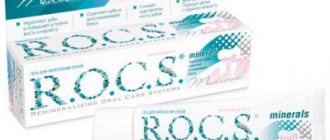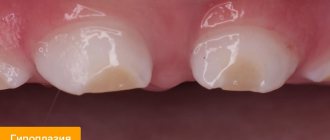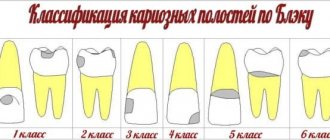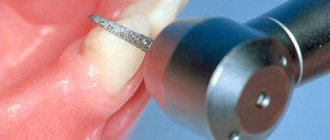Stages of caries
- Initial (superficial, in the stain stage) - a white or brown round-shaped spot forms on the enamel. There is no pain or discomfort. The defect can only be noticed visually. A light color indicates an acute process, and a dark color indicates a chronic one.
- Medium (dentin damage) - the infection eats away the enamel, spreads to the dentin, and forms a cavity in it. Slight pain occurs when biting or applying heat to the tooth. The edges of the cavity are sharp and periodically crumble.
- Deep - the infection reaches the pulp, the tooth begins to disturb constantly, especially at night. The pain is intensified by temperature irritants and sweets. The attacks are strong, but short (last 5-10 seconds).
It is impossible to accurately determine the degree of caries by eye. The degree of damage can be diagnosed only by drilling the tooth. Often, externally, the lesion looks medium, but turns out to be deep, so only the estimated price of therapy is discussed with the doctor in advance.
Contraindications
- Acute stage of ARVI, acute respiratory infections, herpetic rashes
- I, III trimester of pregnancy
- Acute stage of periodontal disease
- Bruxism (night grinding of teeth)
- Seizure attacks
Indications
- Darkening of tooth cusps, cervical areas
- Chipping of a piece of tooth enamel
- Dark gap along the border of the filling
- “Dots”, “spots” on teeth
- Pain from sweet, sour, cold
Experience in microinvasive treatment of caries using the method of enamel infiltration with “Icon” material (DMG)
The article discusses a fundamentally new method of microinvasive treatment of cavity-free enamel caries using the infiltration method.
The constancy of the ultrastructural and microcrystalline architectonics of tooth enamel is ensured by remineralization processes in the oral cavity. Superficial caries is a process of irreversible demineralization of enamel. In the area of enamel damage, 25–35% of pores and microspaces filled with cariogenic microorganisms are found. The state of a stabilized carious process is described, when a protective zone is formed behind the affected enamel zone, separating the carious process from healthy enamel. In all cases of superficial caries, both in active form and in the form of a suspended process, a large number of cariogenic organisms are found in the area of the body of the enamel lesion and often on its surface, the waste product of which is lactic acid.
In the 2000s, a fundamentally new method of microinvasive treatment of cavityless enamel caries using the infiltration method was proposed. The enamel infiltration method is based on achieving a cariesstatic effect by closing enamel pores, which are the “entry gate” for the penetration of acids and the release of dissolved minerals.
The technique was developed by Professor H. Meyer-Lueckel and Dr. S. Paris. It is based on removing the pseudo-intact layer of enamel with 15% hydrochloric acid, followed by filling the lesion with a mixture of synthetic resins that have certain rheological properties (low viscosity) and, accordingly, higher penetrating ability (high penetration coefficient). The table shows the radiological classification of proximal carious lesions according to their depth (Mejare I., 1999).
Table. Radiological classification of proximal carious lesions according to their depth (Mejare I., 1999)
According to S. Paris and H. Meyer-Lueckel (2009), progression of the carious process 18 months after enamel infiltration using the Icon material (DMG, Germany) is observed in only 10% of teeth with proximal carious lesions of the E2–D1 level (in the comparison group - in 38% of teeth, respectively).
The main provisions of the concept of minimally invasive caries treatment:
- Timely diagnosis of carious lesions (measurement of the degree of demineralization of hard tooth tissues using laser fluorescence, enamel electrical conductivity, optical coherence tomography, bitewing radiography, transillumination and other methods);
- Remineralization of initial carious lesions with fluoride and calcium preparations;
- Control of cariogenic microflora (rational oral hygiene, reducing the frequency and amount of refined carbohydrates consumed, the use of fluoride preparations, etc.);
- Surgical intervention with minimally invasive treatment of cavity caries (manual preparation, slot and bat cave preparation, tunnel preparation, etc.).
Indications for enamel infiltration:
- Enamel caries in the staining stage on the vestibular surfaces of the teeth;
- Enamel caries and dentin caries with damage up to half of its thickness (levels E1–D1 according to the radiological classification) on the proximal surfaces of the teeth while maintaining a pseudo-intact layer.
Contraindications to enamel infiltration:
- Treatment of dentin caries when more than half of its thickness is affected (levels D2–D3 according to the radiological classification);
- Cavity caries of enamel and dentin;
- Change in enamel color due to injury;
- Individual intolerance to the components of the material.
Visual diagnosis of carious lesions and determination of the possibility of non-invasive therapy is preferably carried out using optical devices (monocular, binocular loupe and intraoral video camera), which allow observing the surgical field in detail.
The Icon system for the non-invasive treatment of early caries was developed by DMG in collaboration with the Charite clinical complex Berlin and the University of Kiel. The manufacturer recommends using it for lesions E1, E2, D1.
The Icon (DMG) system includes the following components:
- Interdental wedges for separation of proximal areas;
- Etching agent – 15% hydrochloric acid gel;
- Vestibular and proximal nozzles with one-sided perforation for introducing an etching agent and infiltrant;
- Ethanol-containing conditioner Icon-Dry;
- Infiltrant Icon-Infiltrant.
Two options (sets) of the Icon system are offered: for approximal surfaces (Icon Caries infiltrant-approximal) and for the treatment of vestibular surfaces of teeth (Icon Caries infiltrant-vestibular). They differ in the types of attachments and the presence or absence of wedges.
The syringes included in the proximal lesion treatment kit contain material to treat two surfaces. In the case of treatment of multiple lesions of proximal surfaces during one session, treatment of the lesion sites is carried out sequentially.
The syringes included in the vestibular kit contain material for a one-time treatment of two to three lesions. In the case of treating adjacent vestibular areas during one session, treatment of the affected areas can be carried out in parallel.
In Belarus, in particular at the Department of Therapeutic Dentistry of BelMAPO, experience has been gained in working with the Icon system.
Clinical case 1.
Patient E., 24 years old, applied to the clinic of the Department of Therapeutic Dentistry of BelMAPO with complaints about a cosmetic defect in teeth 21 and 22. To objectively assess the diagnosis of foci of the carious process, we used the laser fluorescence microscopy method (KaVO “Diagnodent”), which allows us to determine the volume of metabolic products of cariogenic microorganisms, in particular lactic acid. In this clinical situation, a diagnosis of caries of the enamel of teeth 21 and 22 (E1) was made (Fig. 1.1).
The size of the defects was determined using a LI-2-8x monocular, which allows measurements to be made with an accuracy of 0.1 mm. After the diagnosis was made, it was decided to use a minimally invasive method of treating dental caries using the “Icon” material (DMG).
Before infiltration of proximal caries, the tooth was cleaned using a brush, polishing paste and floss. A rubber dam was applied (Fig. 1.2).
After applying the rubber dam, teeth were separated using a plastic wedge from the set (Fig. 1.3).
In order for the wedge to better enter the proximal part, its handle can be rotated at an angle. The wedge handle was disconnected by turning it. The separating wedge was left in the approximal region throughout the entire treatment session (Fig. 1.4).
The proximal tip was screwed onto an Icon-Etch syringe and inserted into the interdental space with the perforated side facing the affected tooth surface (Fig. 1.5).
With its help, Icon-Etch was applied to the contact surface - an etching gel of 15% hydrochloric acid (1.5 - 2 turns of the piston correspond to the required amount of material) (Fig. 1.6).
Icon-Etch was left to sit for 2 minutes.
The application film was removed from the interdental space and the Icon-Etch was rinsed with water for at least 30 seconds (Figure 1.7).
The affected area was dried with dry air from an oil-free compressor (Fig. 1.8).
To create optimal conditions for the adhesion of polymer resins, it is necessary to completely remove the moisture that is present in the enamel pores after washing with water and subsequent drying. For this purpose, ethanol was applied to the treated areas and dried. The application cannula was then screwed onto the Icon-Dry syringe. Approximately half the contents of the syringe were applied to the lesion and left to act for 30 seconds (Fig. 1.9). Then it was dried again with dry air from an oil-free compressor.
The next stage of treatment is direct infiltration of the lesion. To perform this, a special approximal nozzle was screwed onto an Icon-Infiltrant syringe and the application film was inserted into the interdental space. The green side of the nozzle should be directed towards the surface to be treated, since the material exits only through the perforations (Fig. 1.10).
Before applying the infiltrant, you must turn off the lamp of the dental unit!
Icon-Infiltrant was applied in a slight excess to the affected area (1.5 to 2 turns of the piston approximately corresponds to the required amount of material). The material was left to act for 3 minutes. Icon-Infiltrant was illuminated from all sides for at least 40 seconds (Fig. 1.11).
To reduce polymerization shrinkage and increase microhardness, the material was applied a second time by screwing a new approximal nozzle onto the Icon-Infiltrant syringe. It was left to act for 1 minute and the material was illuminated from all sides for at least 40 seconds. (Fig. 1.12 - after re-polymerization.)
The separating wedge and rubber dam were removed. The structure was polished using polishing strips and discs (Fig. 1.13, 1.14).
Clinical case 2.
Patient A., 27 years old, applied to the clinic of the Department of Therapeutic Dentistry of BelMAPO with complaints of a cosmetic defect in the area of teeth 11 and 12.
To objectively diagnose the condition of hard tissues, we used the method of laser fluorescence microscopy (KaVO “Diagnodent”). The dimensions of the defects were determined using a LI-2-8x monocular, which allows measurements with an accuracy of 0.1 mm. After examination, the patient was diagnosed with caries of the enamel of teeth 11 and 12 (Fig. 2.1).
To treat acavitary caries in this case, the technique of infiltration of carious lesions using the Icon system was used.
Before treatment, the treated tooth and adjacent teeth were cleaned. After removing the plaque, the mouth was rinsed with water and a rubber dam was applied (Fig. 2.1). To apply the etching gel, the vestibular tip was screwed onto an Icon-Etch syringe. By turning the plunger, Icon-Etch was carefully applied to the affected area and allowed to sit for 2 minutes.
When treating caries in the white spot stage, an area of 2 mm around the lesion was also etched.
For better dissolution of the pseudo-intact layer, the manufacturer allows etching of the lesion with 15% hydrochloric acid gel three times, for 2 minutes each time.
Icon-Etch was rinsed with water for at least 30 seconds and dried with dry air from an oil-free compressor. In Fig. 2.2 photograph of the area affected by the carious process after etching with 15% hydrochloric acid gel, washing and drying. The remaining moisture in the enamel pores after washing with water was dried with ethanol. To do this, screw the application cannula onto an Icon-Dry syringe. Approximately half the contents of the syringe were applied to the lesion and left to act for 30 seconds. Dried with dry air from an oil-free compressor.
Before carrying out the actual infiltration, the vestibular nozzle was screwed onto the Icon-Infiltrant syringe. By turning the plunger, a slight excess of Icon-Infiltrant was applied to the etched surface and left to act for 3 minutes (Figure 2.3). Excess material was removed with air from an oil-free compressor.
Since it is not recommended to apply the material to the anterior teeth under direct light from the dental light, it was turned off. Icon-Infiltrant was illuminated from all sides for at least 40 seconds.
The next step is to re-apply Icon-Infiltrant to the affected surface: screw a new vestibular attachment onto the Icon-Infiltrant syringe and apply the material a second time. Left to act for 1 minute and illuminated from all sides for at least 40 seconds. An approximal attachment was used to treat enamel caries on the proximal surfaces of teeth 12 and 11. The sequence of manipulations was similar to the clinical case described above. In Fig. Figure 2.4 shows the stage of caries treatment of the proximal surfaces of teeth 12 and 11 and the vestibular surface of tooth 21 after re-application of Icon infiltrant and its illumination before final polishing. After removing the rubber dam, the surface of the restoration was polished using discs and polishing heads.
Rice. 2.5. – after finishing.
In Fig. 2.6 shows the result of treatment after 3 months.
In Fig. 3.1 – 3.3 the Icon system and types of attachments are presented.
After infiltration of the enamel with the Icon material, dynamic observation is necessary (at least once a year) with regular x-ray monitoring. Since Icon is not a radiopaque material, it is necessary to fill out a special passport for each tooth treated.
Magnification of the object of study using a monocular, binocular loupe and intraoral video camera, as well as examination using laser fluorescence, significantly improves the quality of caries diagnosis and makes it possible to determine the boundaries of non-invasive therapy.
The non-traumatic nature and relative speed of the treatment method (in one visit) determine the high potential for using the drug in a therapeutic dentistry clinic. Based on experience with the materials of the Icon system, we can conclude that microinvasive treatment of superficial caries using the infiltration method is highly effective. An additional advantage of the technology is the restoration of enamel fluorescence in most cases.
Authors: S.A. Granko, O.A. Lopatin, A.A. Esman, S.V. Barannikov
Diagnostics
In our clinic, caries diagnosis begins with an examination. The dentist carefully examines each tooth from the outside and inside, lightly tapping it (percussion). If a source of infection is detected, thermometry is performed - exposing the tooth to cold to assess the reaction. Electroodontometry helps determine the degree of infection development - the impact of a microcurrent on the tooth, to which the inflamed pulp will react. Patients are prescribed x-rays to assess the condition of the root tissues and detect hidden cavities.
Technologies and materials
To diagnose and treat caries, the PROFI-Dent clinic uses a wide range of advanced methods and materials:
- digital pantomograph and radiovisiograph;
- safe, effective anesthetics of the latest generation;
- advanced dental units;
- modern surgical equipment (physiodispenser, ultrasound and laser devices);
- durable filling materials with high abrasion resistance (light-curing);
- inlays, veneers, etc.;
- modern calcium- and fluorine-containing preparations for remineralizing therapy;
- the latest restoration techniques.
The use of advanced diagnostic equipment and the latest materials ensures impeccable results. Our dentistry provides turnkey caries treatment, which includes not only the elimination of inflammation and pain, but also the complete aesthetic restoration of the tooth’s shape using light-transmitting materials.
Stages of traditional caries treatment (using a drill)
- Anesthesia completely removes pain. At DHC, local anesthesia is performed with new generation drugs based on Articaine. The injections are completely safe, hypoallergenic, and have no restrictions or side effects.
- Tooth preparation - excision of carious tissues with a drill. It is necessary to remove all affected tissue, otherwise the infection will recur.
- Creation of a cavity with burs of different sizes with cooling so as not to overheat the pulp and dentin. Inside, the cavity is treated with etching gel to improve adhesion to the filling.
- Installation of a gasket - made on the basis of calcium hydroxide, normalizes blood circulation in the pulp, accelerates dentin regeneration. Spacers are needed when the cavity wall is located next to the pulp.
- Filling with photopolymer materials. Such fillings are durable, similar in color to enamel, and can withstand any load.
- Grinding - adjusting the filling height so that it does not interfere with the closure of the teeth and does not disturb the bite.
Non-invasive methods for caries treatment (without drilling)
- Ozone therapy helps in the initial stages. Carious tissues are not removed mechanically; they are only treated for disinfection with ozone, which destroys 99.9% of bacteria. The procedure completely stops the development of the infection.
- ICON - infiltration of infection at the spot stage. The drug penetrates damaged enamel and makes it durable. The tooth surface becomes resistant to bacteria and organic acids.
- Laser therapy is similar to traditional therapy and is effective at all stages. It differs in that damaged tissue is not drilled out, but evaporated by a laser.
- Sandblasting (air abrasive) treatment is indicated for the treatment of initial caries. The sandblasting machine has the same principle of operation as a drill, but without vibration and contact effects on the enamel.
Non-invasive dental treatment: advantages and disadvantages
Treatment without drilling a tooth using the Icon method is incredibly popular all over the world. Infiltration is considered a safe and fairly successful technology. We list the main advantages of the method:
- the ICON system has a high level of reliability in getting rid of initial carious disease;
- maximum possible preservation of dental tissue and strengthening of the enamel structure;
- ideal for people who experience fear at the sight of injections and drills;
- the patient feels absolutely no pain and therefore feels comfortable;
- The duration of the procedure is 20–30 minutes.
In addition to a large number of obvious advantages, some experts have a negative attitude towards this technique and point out the following disadvantages:
- suitable only for getting rid of initial forms of caries;
- there is no guarantee of protection against the appearance of secondary caries;
- Not all clinics practice treatment without a drill;
- prices for ICON are significantly higher than for installing a filling (approximately 1000–2000 rubles).
Complications after treatment
If the dentist overheats the dentin or injures the pulp during preparation, the tooth will begin to ache after the anesthesia wears off. We'll have to re-open it and depulp it. A lump may appear on the gum after unsuccessful canal sealing if the material penetrates beyond the root. Then you need to re-open the canal, treat the inflammation, then fill it again.
If the filling is in the way, it means that the dentist did not sharpen or polish it properly. This can be easily fixed. The appearance of a reaction to thermal changes indicates a violation of the tightness of the seal. All these complications often arise due to the fault of the dentist. To prevent them, you should carefully choose a clinic and trust only doctors with extensive experience.
High system efficiency
Patients prefer our dental clinic “Vivadent”, as it is one of the best clinics in Moscow, using the most modern, high-quality and effective methods for the prevention and treatment of teeth, tested by outstanding American and European specialists.
We employ highly qualified professionals with extensive experience. We constantly improve our knowledge and skills, study new treatment methods developed by world experts in the field of dentistry. It is very important for our clinic that every patient feels comfortable and receives painless treatment of the best quality at an affordable cost. You can find out more about the list of services and costs on our official website or from the clinic administrator.
Never forget that shining healthy teeth are our calling card, so everyone should visit the dentist regularly. This is the surest way to maintain a great smile for many years and avoid painful treatment.








